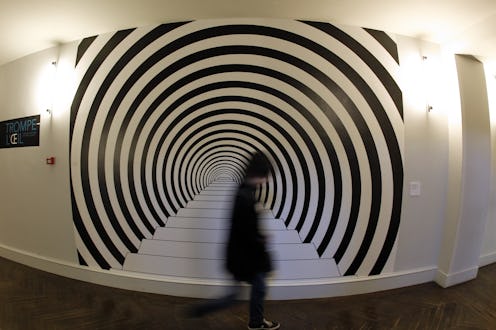Life
Here's How The "Phone On A Rug" Illusion Works
Over the past few days, you might have seen a particular optical illusion involving a rug and a phone floating around on Facebook. But how does the "phone on a rug" optical illusion actually work? Finding out may make you feel better if you're one of the many people who was never able to crack it, because honestly, it's actually really cool.
Technically, the "phone on a rug" image isn't really an optical illusion — or at least, doesn't fit any of the classic categories for optical illusions. Rather, the science behind it is about the psychology of visual search. So from a brain perspective, the reason you have a hard time finding the phone is the same reason you had fun with Where's Waldo books as a child, not the reason the black and white lines in an optical illusion seem to move. But that still is some pretty powerful stuff.
There's still a lot we don't know about the science of visual perception; despite being natural for us, the process of sorting through the visual stimuli our eyes receive and turning it into something coherent is actually incredibly complex and difficult. When it comes to visual search, we do know certain things, however.
For instance, the process of searching for a specific image becomes more difficult the more "distractors" are present — and the more similar the distractors are to the object of your search the harder it is to pick it out. Think of it this way: if you were trying to spot the letter "O" in a jumble of letters, it's easier if the all other letters were "K"s than if they were all "C"s because the letter "C" is more similar in shape to the letter "O."
Which is why, in the phone on a rug image, the fact that part of the rug is so similar to the phone case makes it hard to distinguish rug from phone. We're looking for a phone, but it's hard to pick it out because it too closely resembles the distractors.
The process of visual search is something researchers are still trying to understand (there's actually a lot of ongoing research about it). For instance, when searching for something, do people look for something that corresponds to a mental prototype, or do they try to analyze and identify the images that they actually see? Do people recognize images in pieces or as a whole? What role do context clues play in visual search?
One thing we do know is that, Where's Waldo and certain Facebook posts aside, humans are actually very, very good at visual search — it's one of the reasons we find images that are able to trip us up so fascinating.
But we're also very good at knowing when to give up. So if you threw in the towel on finding the phone, don't feel bad. Not only are you not alone by a long shot, your brain is also just doing its job.
(And If you want to know the answer, look carefully in the upper right portion of the rug, and try looking for the tell-tale iPhone camera, rather than the whole phone.)
